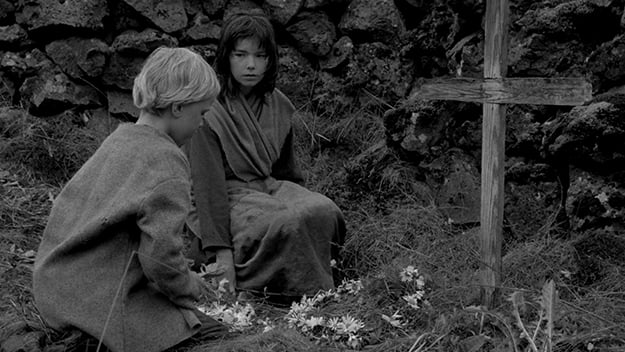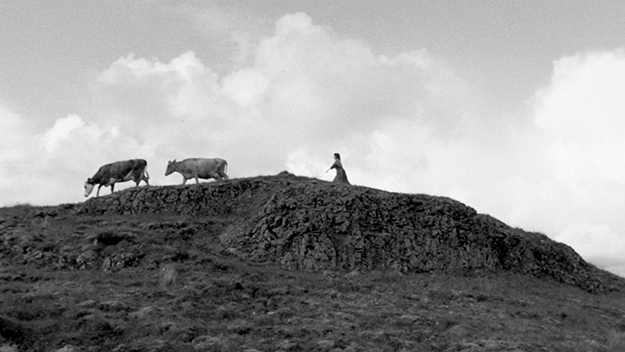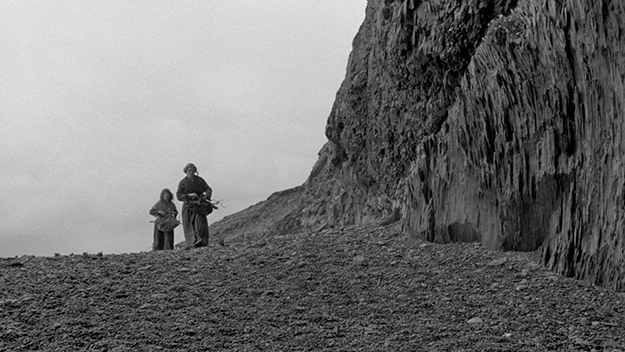Review: The Juniper Tree

The futuristic, melodramatic eclecticism of Björk’s music, videos and multimedia performances has made her reputation as a seer of aesthetic and emotional possibilities not ordinarily perceivable. In her first feature film role, the primarily self-funded debut of a filmmaker whose career would prove to be short on both opportunities and time, Björk played a literal visionary. Margit of The Juniper Tree (1990) is a young woman coming of age in an era of magic and witchcraft, who is sometimes overtaken with an apparition in the form of her dead mother, foretelling ominous and ambiguous hints to the mysteries of the spirit world. Twenty years old when the film was shot in 1986, herself a new mother (and new Sugarcube), Björk in the film seems dazed, not blank exactly, but studious as she absorbs “what the birds know”—a recurrent line in the film, a transposition of a Brothers Grimm tale to Iceland, where ancient and modern meanings are layered sparsely, almost calligraphically, atop the black-and-white landscape.
Opening at the Metrograph on March 15 in a new restoration and touring thereafter, The Juniper Tree was written, directed, produced, and edited by Nietzchka Keene, who died of cancer in 2004. She made just one more feature in her lifetime (a third was completed posthumously); her death was the inspiration for her friend and University of Wisconsin colleague Lorrie Moore’s story “The Juniper Tree.” Her academic career began with Germanic linguistics and folklore, and continued on that track as she studied filmmaking at UCLA while working as a research assistant for a scholar of the Icelandic sagas. She traveled to Iceland for the 1985-86 academic year on a Fulbright—ostensibly, according to the authors of a lovingly researched study of the film, to shoot a film based on an Icelandic tale, but with the idea for The Juniper Tree already germinating.
That Grimm tale, about a wicked stepmother, cannibalism, a bird transformation and a magical tree, provides beats and tropes for Keene’s quite free retelling, which is academic but vibrant in its critical, retrospective version. In this Juniper Tree, Margit and her older sister Katla (Bryndís Petra Bragadóttir) leave their home after their mother is stoned and burned for practicing witchcraft. For security, Katla plans to marry—fortuitously, to a widower farmer, Jóhann (Valdimar Örn Flygenring), whom she appears to love. Still, once she and Margit are settled on Jóhann’s farm, Katla performs rituals to bind him to her, and prepares a poultice to ensure that she’ll bear him another son. Jóhann’s boy Jónas (played by a girl, Geirlaug Sunna Þormar) hates his new stepmother and calls her a witch, imposing sinister implications onto her old-wives’ practices. But it’s the younger Margit (Björk is a bit older than her character) who has the truly supernatural gift of second sight, and Margit with whom Jónas bonds over their grief for their mothers, and their conviction that their mothers’ souls are still present in the world around them.
That the Icelandic cast all speak English—with the congested, almost whimsically delicate accents a subsequent, more global generation of Icelanders are sometimes known to parody—is one clue that this is not an Icelandic story, neither in its German origins, nor in the narrative’s particulars, nor in Keene’s updates. For one thing, of the two-dozen-plus Icelanders burned as witches during the 17th century, all but one was a man. (So… should we call them warlocks?) There are no runes in The Juniper Tree, or huldufólk, Iceland’s rock-dwelling elvin “hidden people.” Like Sokurov in Faust, Nolan in Interstellar, and countless other foreign epic filmmakers and commercial crews, Keene is having Iceland stand in for a realm of the imaginary.


The Juniper Tree was filmed in various locations in south Iceland, including a few that are now Instagram-famous, but here shockingly depopulated: the basalt cliffs and caves at Reynisfjara; the waterfall Seljalandsfoss, where Björk and her dead mother (Guðrún S. Gísladóttir) walk the path behind the falls until they’re lost behind a curtain of spray and the sound of wordless, keening singing. Keene shot interiors in a turf house preserved by the Reykjavík city museum, but much of the action takes place outdoors, on mossy lava rocks, boulder-strewn tiered hillsides heaved up out of the earth, and fields of wind-blown dandelion stalks and angelica in the long, chilly white nights of an Icelandic summer, a time and place where the usual laws of nature might not quite apply.
The Juniper Tree is occasionally amateurish in its blocking, possibly to save film and time—scenes are sometimes covered in a single two-shot, with the actors sitting side by side facing the camera—but the overall effect of the understated delivery is, on balance, more dreamy than drowsy, and the small cast and meager resources become a virtue in other ways. Much of the rest of the dialogue in the movie is clearly post-recorded, so that even diegetic speech becomes interwoven with the film’s heavily verbal, mystical and self-contradictory soundscape. Keene frequently pairs her visuals with the voices of her characters reciting ancient rhymes, folktales about trolls and lost children, incantations and spells, Christian prayers and Bible readings—a swirl of belief, superstition and vernacular wisdom filling in the negative space in this hardscrabble reality.
Arresting images match the surfeit of verbal and narrative symbolism: a single candle singing a lock of hair; sewn-shut lips beneath clear water; the view through a farmhouse’s single, cloudy window. Though the film takes place in a deliberately unpinned-down time and place, the intimation of off-screen witch hunts—the way the killing of Katla and Margit’s mother spurs their flight and haunts their thoughts—remains a potent symbol of gynophobia and female precarity, and sharpens our focus on their motivations. Amid the the body parts cooked into a stew, and the tree that grows overnight, the perspective of the wicked stepmother—the “bad mom,” the interloper in the family—turns out to be quite legible to contemporary observers. Keene is doing the right kind of critical revisionism, adding rather than subtracting—reframing the uncanny, contorted alien logic of folktales within a politically updated dynamic, offering her own interpretation of an old story while honoring its lingering richness.
Mark Asch has written about movies for Reverse Shot, The Village Voice, Little White Lies, and The Reykjavík Grapevine. He is the author of Close-Ups: New York Movies.







